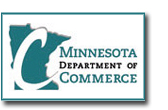 Whether you’re an angel investor listening to startup pitches or an innovator considering funding sources, now is a time to be extra careful with anything related to money, credit, lending or capital of any kind — especially if you’re a participant in a social or affinity network or if you’re transparent with your blog and other online participation (which give scammers lots of ammo to use to pitch you).
Whether you’re an angel investor listening to startup pitches or an innovator considering funding sources, now is a time to be extra careful with anything related to money, credit, lending or capital of any kind — especially if you’re a participant in a social or affinity network or if you’re transparent with your blog and other online participation (which give scammers lots of ammo to use to pitch you).
The Minnesota Department of Commerce just released this 2008 Investor Fraud Traps listing (in alphabetical order) and offer it as a warning:
Deficient Disclosure: The recent investigations by state securities regulators related to auction-rate securities (ARS) have reinforced that investors should remain cautious when pitched complex investment products accompanied by deficient disclosures or when advised to concentrate their investments too heavily in one investment product. It is best to avoid investment pitches that would lead you to put all of your eggs in one basket, especially if it’s a basket you don’t fully understand.
Energy Scams: The substantial increase in energy costs has made scams related to energy more prevalent. State and provincial securities regulators are seeing not only shady oil and gas investments, but also scams that promise the development of new technologies to increase the efficiency of energy consumption or to extract energy from sources previously thought too expensive to develop.
Online Affinity Fraud: In a new twist on affinity and online investment fraud, Tyler said NASAA members are concerned that unscrupulous individuals are trying to use social networking websites to lure people to meetings that may promote fraudulent or unsuitable investment products. “Social networking websites create an environment ripe for affinity fraud,” Tyler said. “Fraudsters can take advantage of the fact people freely share information with both their real and ‘virtual’ friends by posting it to their profile,” Tyler said. “Communication tools provided by some social networking websites make it easy to advertise and promote investment scams to a wide audience for free.” Investors need to do their own research before making an investment and should not simply rely on ‘expert’ advice given at a seminar or meeting.
Prime Bank Schemes: Promises of receipt of astronomical profits from vehicles that execute “off-shore trades of foreign bank debentures” only available to very wealthy people and cloaked in secrecy are the securities equivalent of a purse snatch. They simply do not exist, and once money is handed over, it will never be recovered.
 Private Securities Offerings: Con artists are turning increasingly to private securities offerings under Rule 506 Regulation D of the Securities Act of 1933 to attract investors without having to go through the full registration process. Although sometimes legitimate, these offerings are often associated with fraud. Also, proceed with caution when encouraged to invest in “general partnership” or “limited liability companies.” Speculative deals often are packaged as such in an attempt to evade the consumer protection requirements of state and federal securities laws.
Private Securities Offerings: Con artists are turning increasingly to private securities offerings under Rule 506 Regulation D of the Securities Act of 1933 to attract investors without having to go through the full registration process. Although sometimes legitimate, these offerings are often associated with fraud. Also, proceed with caution when encouraged to invest in “general partnership” or “limited liability companies.” Speculative deals often are packaged as such in an attempt to evade the consumer protection requirements of state and federal securities laws.
Promissory Notes: For sophisticated or corporate investors, promissory notes can be a good investment, providing a reasonable reward for those who are willing to accept the risk. However, promissory notes that are marketed broadly to the general public often turn out to be scams. Promissory notes are sold as instruments that guarantee above-market, fixed interest rates, while safeguarding their principal. When interest rates are low, investors may be enticed by the higher, fixed returns that promissory notes offer. These notes, however, can become vehicles for fraud when the issuer of the note has no intention or capability of ever delivering the returns promised by the sales person; leaving the note worth less than the paper on which it is printed.
Pump and Dump Schemes: E-mail and fax spam, phony press releases and telemarketing drives are the tools of fraudsters who “pump” up the value of low priced securities traded on the “pink” sheets which are then “dumped” on naïve investors who purchase the stock at inflated prices. The balloon breaks when the promoters no longer maintain the myth that there is value in the shares and investors are left holding worthless stock certificates.
Real Estate Investment Schemes: As the housing market continues to reel from the subprime lending crisis, schemes promising large returns from various types of real estate-related investments also are increasing. Some real estate alternatives may actually be worthless real estate investments that promoters are trying to dump off to unsuspecting retail investors. State and provincial securities regulators also note that “reverse mortgages” pose several risks: they may not be appropriate for a given investor; if the homeowner chooses the option of accepting the funds all at once in a lump sum it may create a sudden supply of cash that may be diverted into other bad investments; and they enable promoters to gain access to a senior citizen’s entire financial profile. Such disclosure of other assets can lead to yet more scams—and losses.
Sale and Leaseback Contracts: Seeking to avoid protections afforded under federal and state securities laws, investments in equipment or animals are proposed to investors with the promise of a high returns and a guaranteed future repurchase of the product at full invested price. While these investments are touted as safe, the buyback features are unfunded and illusory.
Unsuitable Sales: State and provincial securities regualtors continue to see the sale of complex hybrid financial products, such as variable and equity-indexed annuities, to investors for whom they are not suitable—typically seniors. These products frequently contain features so complicated that even licensed financial professionals are not adequately trained to understand them.
To read the North American Securities Administrators Association press releases about each category (which contain deeper explanations and more info), look at their “Top Investor Traps” page from which the MN Dept of Commerce alert was derived.